Pantex Blog
JTAs: Testbeds provide vital data to NNSA engineers, military
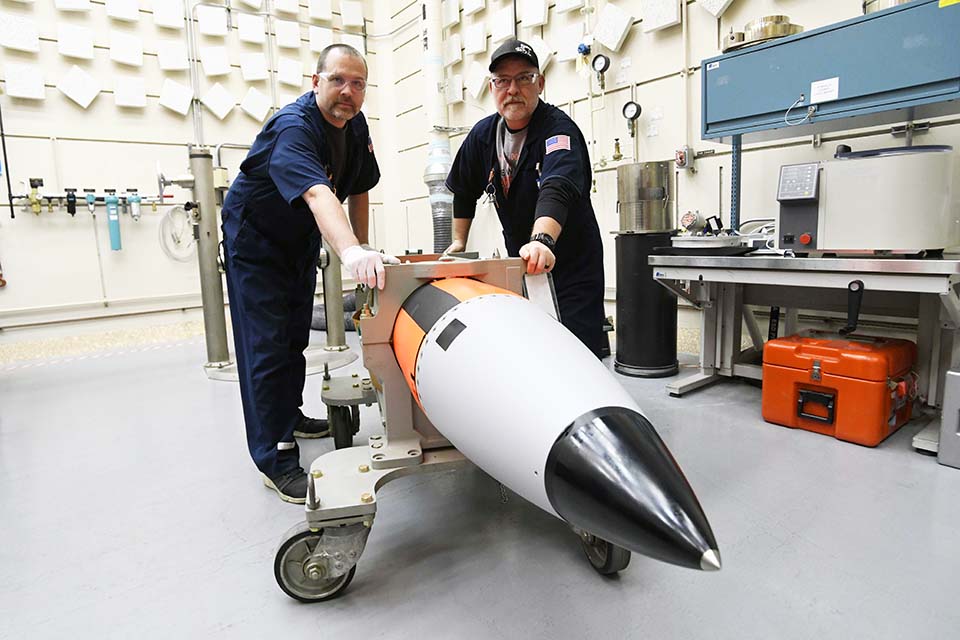
JTAs: Testbeds provide vital data to NNSA engineers, military.
In September 1992, President George H.W. Bush ended explosive testing of the United States’ nuclear arsenal less than 2 weeks after the so‑called “Divider” detonation at the Nevada Test Site. Though few at the time expected it would be the nation’s last live‑fire nuclear test, the Clinton Administration decision 4 years later to sign the Comprehensive Nuclear Test Ban Treaty marked an undeniable turning point in the nuclear weapons era.
Clearly, the end of live testing did not end the U.S. nuclear weapons enterprise. Today’s weapons are significantly more advanced than those of the Cold War. However, without actual detonations, how is Uncle Sam to keep his nuclear spear honed for a battle he hopes never to fight?
One key answer to that question lies in three simple words: Joint Test Assembly.
“JTAs are nuclear explosive look‑alikes,” Production Manager Curtis Chamberlain said.
These mock‑ups look and respond like a completed weapon, but lack a physics package and other components. What they do have, Chamberlain explained, is the ability to record and/or transmit telemetry that feeds valuable data to National Nuclear Security Administration scientists and engineers. Without the risk to human life or the environment associated with a nuclear blast, JTA flights augment virtual testing which drives the modernization and lifetime‑extension programs at Pantex and NNSA labs elsewhere.
Following assembly by teams of adeptly trained Pantex technicians, each resulting “test weapon” records “how it is doing in flight and that everything is happening according to plan — just how it would in the real world,” Chamberlain said.
After some JTA flights, the assembly may be returned to Pantex for disassembly and recovery of additional performance data.
“The data collected during JTA assembly is strictly focused on surveillance,” said J.D. Harris, a former production manager. “It helps the design agencies with annual assessments to … maintain certification on the weapon program.”
It is a complex, ongoing process that balances the need for an understanding of how devices age, the effectiveness of new modifications, and the given quantity in the nation’s inventory. While JTA testbeds may not produce a proverbial big boom, the impact of their assembly, disassembly, and analysis are just as far reaching.
“There are quality driven tests as part of the assembly process,” Harris confirmed.
One system assembled at Pantex, the B61 12, is the twelfth iteration of a munition that entered service at the height of the Cold War as an unguided air‑dropped nuclear bomb. Another system, the W88, entered the stockpile in 1988 as a submarine‑launched system. Regardless of which system is involved, JTAs are a normal part of a weapon’s life cycle.
Chamberlain and Harris explained that the NNSA lab responsible for a given weapon system — B61 12s, W88 Alt 370s, or any number of others — determines the annual number of JTA flights to conduct. Lab staff then coordinate with the expert technicians at Pantex, ensuring the necessary components are included in each assembly, depending on what functionality each flight is designed to test.
Building and dismantling a JTA requires its own qualification program. For the men and women of these programs, the payoff is knowing that their work allows NNSA officials to assure the president of a secure nation. Occasionally, Chamberlain noted, there might be an additional bonus.
“The reward is that I am sometimes able to send [my team to observe] flights,” he said. “They get to see their product in use.”
Today, thanks to the teamwork and skills of Pantexans and their NNSA colleagues, thoroughly updated and modernized B61‑12 and W88 Alt 370 programs remain vital resources in the nation’s deterrent force.
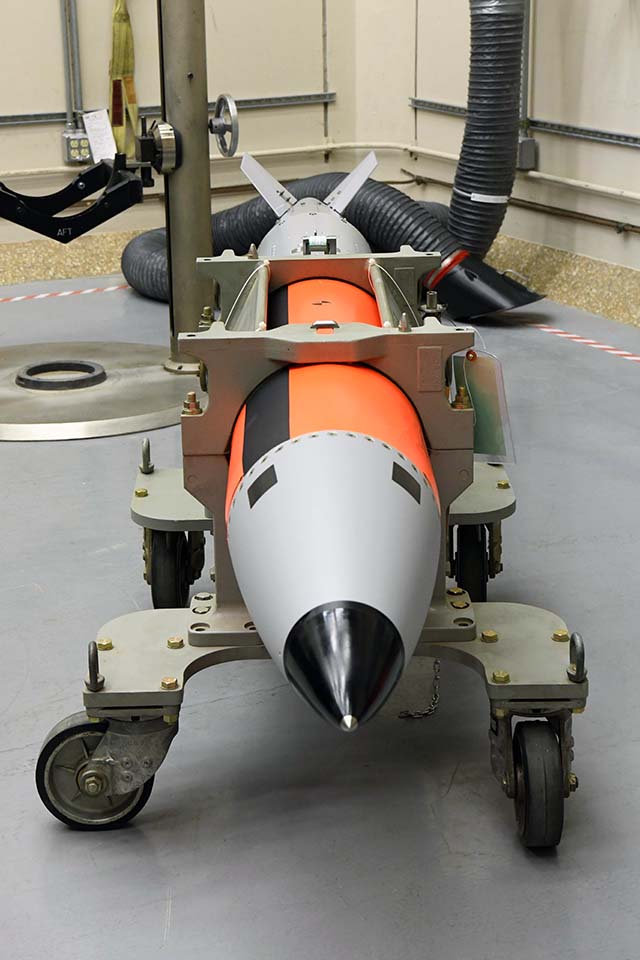
B61 Mod 12 Joint Test Assembly
Building Pantex City: A village is born
“It takes a village.”
That phrase, echoing a proverb about the emphasis on family and community in raising children, also applies to a time about 70 years ago in the heart of the Texas Panhandle.
In 1943, housing was at a premium in the Amarillo area, and with the war effort and production at Pantex already in full swing, along with a growing workforce, the need for new homes was obvious.
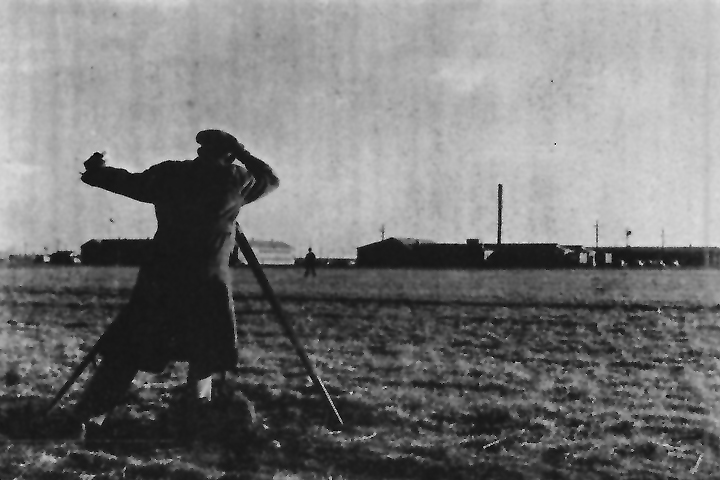
Engineer Ed Groman surveys the northwest boundary corner of the Pantex Housing Project in 1943.
The National Housing Administration (now, the U.S. Department of Housing and Urban Development, or HUD) approved 175 new homes for Pantex employees with three or more family members, but even that was not enough. So, an additional 360 one-, two- and three-bedroom apartments were built.
It was all part of what was then called “Pantex City,” located just north of U.S. Highway 60 and Farm-to-Market Road 683. Along with apartments and homes, the village included plans for a shopping center with a grocery store, meat market, fire station, drug store, barber shop, beauty parlor, shoe repair, and a tailor shop. There was also talk of a possible grade school with plans to bus students back to town for high school.
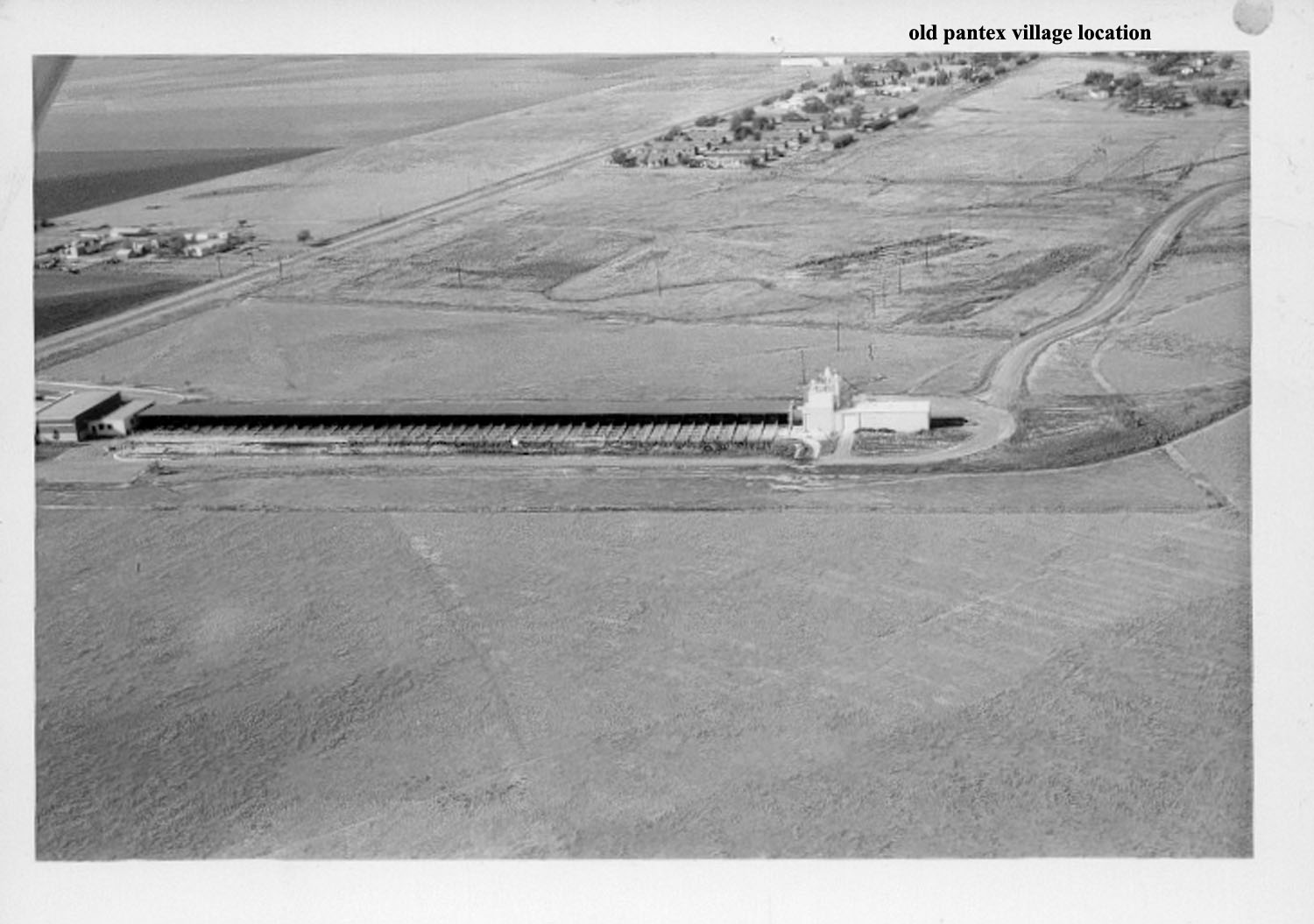
Site of the Pantex Village
Thanks to pre-fabricated, mass-production methods, construction was slated for completion in April 1943. Dwellings went up like Tinker Toys with each unit comprised of four to eight apartments. An additional 400 pre-fab homes were added, bringing the population of the Pantex Village up to a few thousand. The village grew to 69 residence buildings, a community center, and a store, supporting the approximately 5,325 Pantex employees working three shifts at the height of World War II.
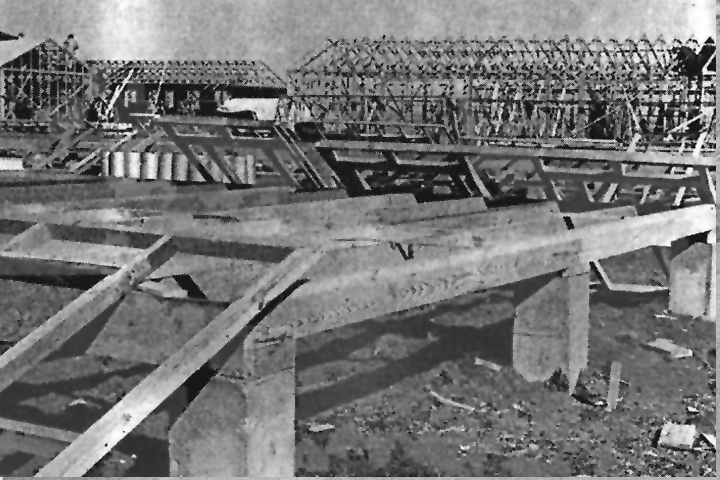
Construction of the pre-fab housing units at the Pantex Village
Before the war’s end, the village was fairly isolated, functioning as a self-sufficient community. It was 10 miles from the town of Panhandle and accessed only through a perimeter gate, which was locked each evening. There were recreational facilities, especially for the younger set; including basketball and tennis courts along with a teen club for dances.
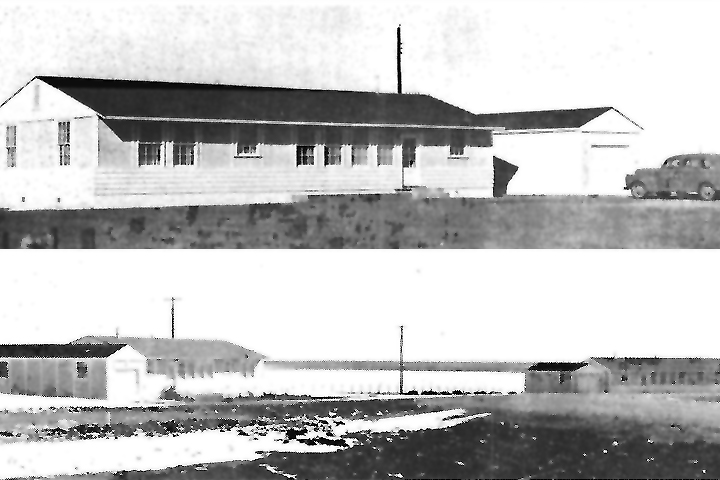
Housing barracks
As a village, there was also a small newspaper called the “Pantex Breeze.” There were no real village officials, as the place was run like a housing project; there was a manager but no one was ever elected as an official to preside over the village. To some outsiders, the village was known as the low-income “Cardboard Village” due to the pre-fab materials and walls so thin you could hear neighbors talking.
In 1949, the plant and village were acquired by Texas Technological College (now Texas Tech University), and by the end of that year, the village was turned over to Carson County. It was still going strong in the early 1950s with apartments ranging from $33 to $42 per month and all utilities paid. After years of rotating chaplains, the Baptist church and Church of Christ moved into permanent buildings within the village early 1950s.
In an article published in the Texas Observer magazine called “Letter from the Panhandle,” noted cowboy poet, author, and former village resident Buck Ramsey reminisced about his time at Pantex.
“On the western edge, the government constructed a village; symmetrical rows of buildings so uniform there was a nightly problem of entering the wrong apartment by mistake. The war industry, with its promise of regular paychecks and dwellings with gas heaters and indoor plumbing, lured many families from the hardscrabble countryside. Mine was among them.”
But all good things come to an end, and in 1968, Pantex Village closed due to the Amarillo Air Base being shut down the previous year and the resulting large number of vacancies caused by improved economic opportunities elsewhere.
Ads were placed throughout the Panhandle announcing that the village buildings were all to be sold at auction. Some of the smaller buildings ended up being sold and are reportedly still being used in the town of Panhandle for storage.
However, the most surprising outcome of the auction can still be found on the east side of Amarillo, on Interstate 40 at one of the city’s most heavily advertised and well-visited tourist destinations. The Big Texan Steak Ranch, famous for its “free 72-ounce steak, if eaten within an hour,” has a surprising Pantex connection.
Owner Bob Lee purchased and dismantled five barracks picked up at the auction and used the lumber to build his restaurant in 1960. Reportedly, most of that wood was lost in a fire in 1976, but the restaurant was rebuilt with the help of 100 of his employees pitching in to help out.
Just like a time more than 30 years earlier… it took a village.
I am Mission Success: S. McIntosh

Take 5 minutes and learn about operations supervisor S. McIntosh. All views and opinions are the employee’s own and do not necessarily reflect those of CNS.
You are a Pantex production technician and you need some paperwork? Need a part as soon as possible? Need a friendly ear? Operations Supervisor S. McIntosh is one of the "go-to" problem solvers in her program, and while she prefers to let the efforts of her hard-working PTs speak for her, she has received recognition, including being named the Production Section Manager of the Quarter in June 2021.
Throughout her life, McIntosh has been familiar with multiple sides of the nuclear dice: An Air Force brat raised on stories told by her dad, she began her professional career in nuclear medicine before moving to the weapons side.
She and her family were living in Kansas when, in 2004, her husband got a job at Bell Helicopter and they made the move to Amarillo.
At that time, she worked as a radiographer and nuclear medicine tech at both area hospitals, Northwest Texas and BSA. In 2015, she transferred to a different side of the nuclear dice when she came on board at Pantex, using her training and experience in a new way. It was a change she embraced with enthusiasm.
“When I started here, I was in awe of the work we do,” she said. “I remember pushing in the first weapon I ever worked on and saying to my teammates, ‘Is this not the coolest job?’ No one does what we do here at Pantex. I loved the transition.”
How does patriotism factor into your life? Did your level of patriotism change after working at Pantex?
My father is a retired Air Force veteran who served and fought in both the Vietnam and Korean wars. He spent part of that time working with nuclear weapons. As a kid, he would tell me many stories about his time in the Air Force, and although I knew that the military would not be my path, I have had a strong sense of patriotism my whole life.
I am very proud to work for a company that provides our nation’s nuclear deterrent and so grateful for our military men and women who serve and sacrifice for our country.
What is your favorite aspect about your work environment? How does that aspect make you know the mission is being met?
I love when different organizations collaborate to enhance our processes. Being a part of these meetings allows everyone participating to hear about obstacles each of us face and how we can come together toward a resolution. We are better together and only succeed if we work together as a team.
As an employee, what do you want to be remembered for?
I hope that I am remembered for my hard work and compassion.
What work advice would you offer someone who is new to Pantex?
Learn as much as you can from as many as you can.
We have so many talented and knowledgeable team members at Pantex. I think it is important to dive in and understand how each organization functions on a high level to ensure that we meet our commitments and to provide a quality product that our customer expects.
What is your top bucket list item and why?
I am not an adrenaline junkie, so skydiving would definitely not be on list!
One thing I have always wanted to do is to go to the Crater of Diamonds State Park in Murfreesboro, Arkansas, and dig for diamonds. With any luck, I’ll find something!
I am Mission Success: Kristy McWilliams
Take five minutes and learn about CNS's Kristy McWilliams, vice president of CNS Safeguards, Security, and Emergency Services (SS&ES). All views and opinions are the employee’s own and do not necessarily reflect those of CNS.
Kristy McWilliams has lived by the life maxim that you never know where life will take you.
“I never envisioned as a young adult that I would be in a leadership role working to protect the nation’s nuclear deterrent,” she said. “I encourage everyone to open their minds to trying new things and taking on new challenges.”
McWilliams was named the vice president of CNS Safeguards, Security, and Emergency Services (SS&ES) in December 2022, and prior to that, she served as the first female senior security director at Pantex.
McWilliams is a graduate of Texas Tech University with a degree in accounting. In her current position, she serves as the senior leader over the SS&ES organizations for both Pantex and Y-12.
McWilliams started at Pantex in 2002 in the finance organization and was quickly matrixed over to the Safeguards and Security organization to serve as its financial analyst.
“While in this role, I was fortunate to have leaders and mentors within the security organization that provided me with opportunities to learn about the operational side of Security,” she said.
She then moved into various security positions including program manager, security group leader, deputy division manager, and division manager.
McWilliams’ advice to others is to take advantage of every opportunity given to you, regardless of what the opportunity might be.
“I have a sign in my office that simply states ‘work hard and be nice to others.’ That is the advice that I give to anyone,” she said. “You truly are a product of your experiences, good and bad. So embrace them, learn from them, and be willing to share them with others.”
What daily task (specific meeting, report, etc.) lets you know you’re helping achieve the CNS mission? How/why does that task let you know you’re working toward the mission?
Being able to witness, on a day-to-day basis, all of the hard work and dedication that members of the SS&ES organization exhibit. It is by their commitment that my organization is able to meet the mission each and every day, 24/7.
What is your favorite aspect about your work environment? How does that aspect make you know the mission is being met?
My favorite aspect about my work environment has to be the people. I am fortunate to work with a team full of security and emergency management/fire department professionals. They make the mission look easy and I am so proud to be a small part of the team.
What work advice would you offer someone who is new to Pantex or Y-12?
I would encourage them to really learn all that they can about the Pantex and/or Y-12 mission. I would also encourage them, every now and then, to stop and really think about how important they are to global security. It is easy to get caught up in the day-to-day duties of our jobs, so I would recommend that they reflect on the fact that they are one of a very few people in the world do what we do at Pantex and Y-12. It doesn’t matter what role they play at either site; they are contributing to the very important mission for our nation.
What’s your top bucket list item and why?
I don’t really do bucket lists…. maybe I should, but I have lived my life without a lot of pre-planning. I’m not sure if that is good or bad, but so far it seems to have worked for me.
I Am Mission Success: Katie Paul
Take 5 minutes and learn about Krisha “Katie” Paul, Pantex’s Cultural Resources Management Senior Associate. All views and opinions are the employee’s own and do not necessarily reflect those of CNS.
Any new hire at Pantex — and there have been lots of them of late — can tell you that the first week is a fire hose of information. They have full days packed into in a full week of learning about all the puzzle pieces that create the mosaic of Pantex. One of the friendly faces new hires can count on seeing is Pantex’s historian, Katie Paul, who provides the newbies with a fascinating glimpse into the rich history of their new work home.
A relatively new employee herself with about a half-year of experience under her belt, Paul oversees a wide range of responsibilities at the plant. In addition to teaching new hires and visitors, she gives tours, oversees the plant’s compliance with environmental laws, assesses buildings for preservation and historical integrity, and catalogs and maintains artifacts related to the plant’s World War II and Cold War missions.
An Amarillo native, Paul went to college at West Texas A&M University in nearby Canyon and received a graduate degree in history. She then gained a fascinating range of experience with various jobs working for WT’s School of Engineering, the Amarillo office of the Texas Department of Transportation, and the Panhandle Regional Planning Commission.
“I’ve been an administrative assistant, a planner, a grant writer, and a city manager,” Paul said. “I’m glad to have found my home here at Pantex, sharing my love of history with employees and visitors alike.”
Are you doing what you envisioned as a young adult? If so, describe how you got here.
From a young age, I loved history. I had no idea that I could make this kind of a career out of a subject most people find boring, but I’m very glad to have been able to join the Pantex family! When I began studying history in college, my goal was to work in a museum, but plans changed and my career took me down a different path.
This position at Pantex is really the best of all worlds: part museum work, conservation work, communication, networking, and writing. These are all things that come from both professional and educational experience. It is amazing to be able to come to work, practice history, share history with my peers, and work with people who are all dedicated to the mission and service to the United States.
What is your favorite fact about Pantex’s history that you enjoy sharing with the new hires?
My favorite era of Pantex history is our World War II operations. It’s such an amazing thing that we were able to transform farmland into a fully functioning industrial operation in just 5 months. It was so important for the Allies’ success in the war — and we still use buildings that were involved in that early World War II work.
I thoroughly enjoy hearing the Pantex story from the beginning and understanding the complex pieces of government that went into standing up factories for war production — and what a tremendous feat it was.
What CNS principle drives you to be successful?
All of the CNS guiding principles provide motivation for achieving success and upholding our mission, but my favorite is “promote a questioning attitude.” Though I am a historian and most people think history is dates and facts, there are always questions to be asked and answers to be found.
As a history buff, what is your recommendation to other Texas Panhandle history buffs?
I always recommend the Panhandle-Plains Historical Museum in Canyon because it has such a wide variety of collections. They have antique vehicles, branding irons, a petroleum exhibit, fine art, firearms, geology, paleontology, and something for just about everyone. They have enough rotating exhibits that you'd be able to find something new to see even if you visit several times per year.
What is your favorite outside-of-work activity and why?
I am very interested in 3-D printing and modeling. I have a 3-D Fat Man replica on my desk that I printed with my home printer and painted. It’s such a fun way to be creative and exercise the technical part of my brain.
